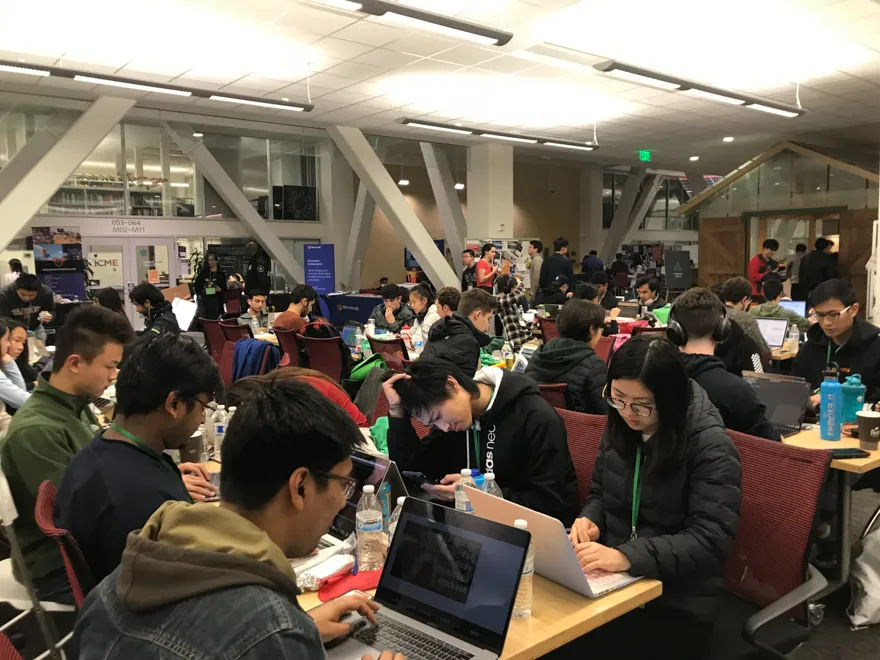This past weekend, Stanford hosted its fifth annual TreeHacks, a 36-hour hackathon that drew 1,254 students from 95 universities. Participants submitted a total of 181 projects.
This year, TreeHacks was themed after Safety, Health and Awareness, the three “verticals” on which students focused their projects.
At the end of the hackathon, a winning project was selected from each vertical. Best Health Hack was awarded to Seek, an AI assistant for the visually impaired; Best Safety Hack was awarded to MapPal, a personal safety assistant that detects if a user is potentially in danger; and Best Awareness Hack was awarded to BubblePop, an app where individuals can anonymously proclaim their opinions on various articles regarding pressing issues. A total sum of $100,400 in prizes, varying from iPads to cash prizes to dinner vouchers at Michelin-starred restaurants, was awarded to these three teams in addition to select runner ups and winners in additional categories.
Participants were evaluated for creativity, technical complexity and social impact by a panel of five judges including Li Fan, Chief Technology Officer of Lime, Geoff Ralston M.S. ’87, a partner at the startup accelerator Y Combinator, and Jamie Hyneman, who formerly appeared on the show Mythbusters.
“Our goal is for people to code intentionally,” said event organizer Joy Hsu ’20. “We want people to code for good, and we hope these verticals can guide these hackers to make tech for good.”
The event kicked off with keynote speaker Scott Forstall ’91 M.S. ’92 — best known as a leading software engineer for Apple during the development of the iPhone and iPad — and later featured speakers from Facebook, Disney and other companies. In addition to coding their projects, teams could participate in workshops hosted by companies such as WiX, Microsoft and IBM, or enjoy tours, play with puppies, practice yoga or participate in an escape room.
“I’m definitely running on a lack of sleep, but this environment is very exciting,” said Winnie Wang, a sophomore at City College of San Francisco. “This is definitely not something you can get in the classroom. Despite just the culture of people coding on the outside, we’re really just trying to foster a very fun and welcoming community of creative people.”
“We thought it would be a good way to stretch our imagination and try and solve problems going on in the real world,” said Jason Zhu ’22, who designed a website that determines a region’s risk for wildfire. “We wanted to put our coding skills to test and learn something new along the way as well.”
Hsu said the event is designed for people to leave “inspired to do more for the world with technology and recognize they have the power to do that and they can do that with any amount of time.”
“There’s some sort of energy because everyone here wants to code,” said Soumya Duriseti, a freshman at the University of California, Davis who designed an app that converts newspaper articles to social media hashtags in effort to promote readability and limit the spread of fake news.
“No one would take time out of their social life if they don’t enjoy coding and that just inspires all of us to continue focusing on what we’re doing,” Duriseti added.
In addition to workshops and fun activities, participants were provided with complimentary meals, caffeine and workspaces across the Jen-Hsun Huang Engineering Center for the entire duration of the event.
“It’s kind of a whirlwind,” said Saahil Chadha, a freshman at University of California, Berkeley. “There’s a lot of activities and workshops going on, people having fun, but then there’s also us who are trying to figure out why the errors are happening in our code and smashing our heads against our keyboards. It’s like pure ecstasy mixed with unadulterated anger.”
Contact Udani Satarasinghe at usatara ‘at’ stanford.edu.
